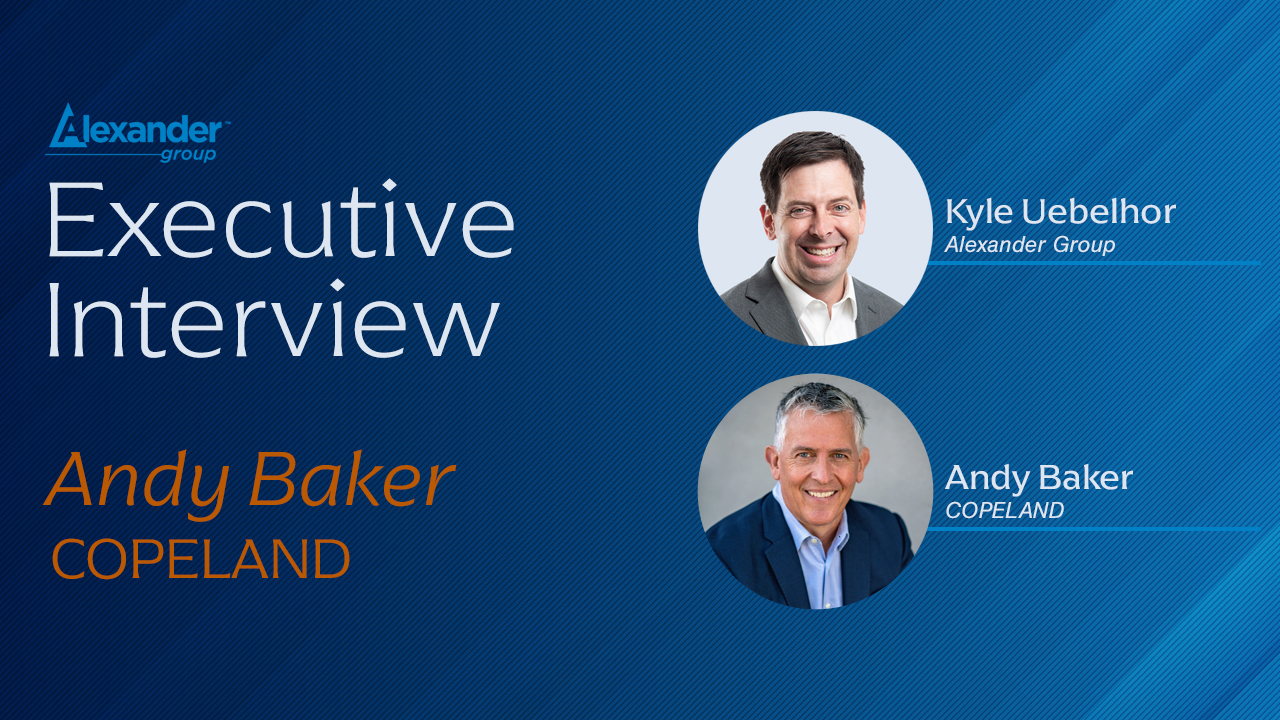Kyle Uebelhor: Hi, everybody, and welcome to our next installment of our executive interview series. I’m Kyle Uebelhor with the Alexander Group. And as you might know, Alexander Group is a strategy consultancy focused on the commercial organization. And today we’ve got a really interesting topic that we’ve been hearing a lot about with our client work. And as we’re out doing research, I’m joined today by Michael Homula. Michael, tell us a little bit about RPM and who you are and why this topic of the CRO, the CCO, the COO, all these things out there are changing and where we’re at. I’d love to know more about you guys as we start.
Michael Homula: Yeah. Thanks, Kyle. I really appreciate you having me. And we value our partnership with AGI very much. So I’m the founder and managing partner of RPM Search Group, which actually stands for Revenue and Price and Profit Management. And we are a retained boutique executive search firm that specializes in the identification, the evaluation, and the subsequent placement of what we would call commercial engine. The commercial side of a business talent that clearly stands out amongst their peers. So we are a consulting firm to our clients first, and then subsequently a firm that helps them uncover the right talent that drives top-line revenue, commercial strategy excellence and profit performance and margin performance.
Kyle Uebelhor: You’ve been a friend of the firm for quite a while, Michael, and you and I have had a lot of good conversations. And our paths cross frequently. And I think the reason we wanted to have this conversation today is that we’re both seeing a high degree of change and some uniqueness to what’s going on with this whole concept of who is the ultimate owner of that revenue, owner of that structure for the commercial engine, as you said. And we’re seeing the differences, like changes at the C-suite level. We’re seeing it across all of our industries that we participate in. And I know you’re seeing it as well. What have been some of the biggest movers for this? What’s caused this change in the past, call it 3 to 4 years?
Michael Homula: Well, I think a lot of it is, complex organizational structures, are reacting to a complex business landscape. Things are changing rapidly, all over the business landscape from, who owns, operations to who owns revenue to who owns strategic pricing, who owns command and control. Companies are trying to get to a unified execution across the C-suite rather than having kind of these iron-fisted individuals that, kind of control their own domains, and they’re trying to execute their own individual strategy strategies within their fiefdom. So I think it’s coming from an evolving and complex business landscape that I’ve seen change over the last, 4 or 5 years really post-Covid. I think it’s really accelerated this. I think we saw signs of it pre-Covid, but I think it’s accelerated post-Covid. And so companies I think, are trying to get more definition to who owns revenue, who owns margin performance, who owns customer excellence, and then somehow trying to unify a strategy across that entire C-suite.
Kyle Uebelhor: I completely agree with you. And we’ve seen the same thing. And it’s ironic. I hate going back to an event like Covid as the as the catalyst. But I think I think it was an accelerant. I think that’s what caused the complexity with our buyers, with our customers, the people who our clients try and serve. And then it’s like that. Plus, the old way we’ve been doing things has created kind of a really unique challenge. You know, Michael, before we go further, let’s talk a little bit. You know, we hear a lot of different terms for who owns revenue. I think the the big three that we see typically are, hey, it’s a CRO or you might have a CCO, a chief revenue officer or the chief commercial officer or the COO chief operating officer. And then there are a couple other flavors as well. Do you want to speak to each of those just a little bit to help people kind of get some context what the although there is no tried-and-true definition, there is a little bit of uniqueness for each of those roles.
Michael Homula: I think that what we have seen over the last four years is companies oftentimes are elevating the chief revenue person, whoever that is, whatever the title is, to more senior levels in the organization. So whereas I would argue in the 2000 teens, we would see these roles like VP of sales, SVP of sales. And then we started to see the emergence of what we now know as a chief revenue officer. That’s now in the executive suite. Historically, these roles have always reported maybe to the CEO, but usually they were reporting to a COO. Now these roles are being elevated to the C-suite over the last 5 to 7 years. So what we have seen is really two significant roles emerge, a chief commercial officer and a chief revenue officer. Fundamentally, what we have seen as the difference is, is the chief commercial officer typically is owning all of commercial strategy for the business, which would include revenue, marketing, sales, operations, sales effectiveness and enablement. And very often the customer or client experience is rolling up under that role as well, particularly in software organizations, whereas the chief revenue officer oftentimes is a little bit further downstream in that cycle. they’re more at the front end of the sales spear, if you will, deploying the best team to meet the revenue objectives of the business. Sometimes companies are slapping titles on these willy nilly. I call it putting lipstick on a pig. They haven’t defined what the role actually is, but they’re just interchanging the titles. Whereas we we think there are big differences between the two roles.
Kyle Uebelhor: And I think that’s right. And I agree with you I see a lot of it. and I think it’s really important to say, hey, what is it you want this function to own? And who are they responsible for with regard to the direct reporting responsibilities? And then what part of the customer lifetime value? I think that’s the piece that we are. All we’re looking at here is how do we elevate customer lifetime value, either in a software company with recurring revenue models or a traditional industrial where we’re just trying to make sure we’re delivering value that we’ve promised to our clients. That whole continuum requires a bunch of different steps. It used to be siloed marketing, sales, service, and now we need to think of this holistically because the customer doesn’t care what function helps them. They want an answer.
Michael Homula: And thinking about it holistically I think is a very it’s a competitive advantage to the companies that have started to figure this out, because it’s a more unified strategy across the entire revenue engine. As I spoke to at the very beginning of this conversation, it used to be you had these kind of tight fisted C-suite executives who owned their fiefdoms, and they were they were operating within the overarching strategy of the business, but they were almost setting their own individual strategies within those lines of business. Whereas now under a chief commercial officer, as an example, where the CMO and the chief revenue person or the senior most customer person are all reporting up into them, there’s a much more overarching strategy that’s aligning with more global business demand. The need to innovate more quickly, the need to read and react to market conditions really fast. I mean, the one thing we know, we’ve seen this developing over the last 20 years, but it’s been, I think the rapid acceleration of how quickly companies have to make decisions is shocking compared to where we were four years ago. Market dynamics are changing so quickly that having, these roles rolled up under one leader, where there is the ability to make very quick decisions, even in large organizations that have historically struggled to make fast decisions, they’re able to make quicker decisions now because there’s much more unification across the commercial engine.
Kyle Uebelhor: Michael, I want to peel that back just a little bit because I completely agree with you. So just going one level slightly deeper, one of the things that I’m oftentimes asked, and that is to say, how do I know whether I need a CRO or a CCO or is that chief operating officer who may have been off to the side for a while, we just sort of put more under his or her plate. Is there is there a formula to say when to pick which one?
Michael Homula: I don’t think there’s a hard and true formula. I think that, you know, as we’ve worked with clients to sort this out and believe me, we do, a lot of times our clients will come to us and say, we want to hire. I’ll give you a great example. Just last year we had a client, middle market manufacturer, about 500 million in revenue came to us. And like, we need a CRO, the private equity partner behind them. Yeah, we need a CRO. And what I often do at that moment is I say, okay, define what it is you need this person to do. What’s the short-term objectives? What are the mid-term objectives? What are the long-term objectives for the revenue growth of the business? How are you handling profitability? Who owns pricing? Who owns marketing? Who owns customer experience? All of those things. So we have a pretty deep discovery process that we go through to help understand what it is that you really need them to do. That then defines whether or not it’s a chief commercial officer or a chief revenue officer. It’s a bit of a broad way to answer your question, but in a more granular way. What we what we find is that when companies start saying that we need somebody to own the business model and the commercial strategy, we need them to own sales management and effectiveness.
We need them to own marketing. We need them to own the customer experience, and we need them to really work closely on innovation and new product development. Well, you just described a CCO versus a CRO, whereas when they start talking about more what I would call downstream, and I don’t mean that in like a discouraging way to somebody sitting in a CRO role. I’m saying that that role, when they start saying I need them to design the sales team and the sales mix, what’s our what’s our channel partner strategy look like? Aligning the sales team to geographies and products and services. we need people to build comp plans for sales teams. How do we develop the next generation sales leader? Now you’re talking in my mind, a chief revenue officer. more than a CCO. I also will say that I, I think that the one other differentiator I’m sorry to interrupt you is to some degree, how big is the business and what is it that you’re selling? Manufacturing companies are going to think about this differently than a software company.
Kyle Uebelhor: Exactly. And I think that’s right. And you just alluded to that. There’s a lot of nuance that needs to go into this. I think one last way, and maybe you can validate with just a yes or no. One last way that we see it and think about it is the CRO oftentimes owns that customer facing organization. Yes. And the CCO is about not just that, but also the front of the funnel. What is our next product innovation? How do we how do we manage product lifecycle? Where are we going to go next. And it’s that’s that that sort of balances between the two. And you can do they both need to get done. It’s just a matter of who and how do we want to actually put it in the right. In the right. valence I guess the right.
Michael Homula: I completely agree with you. That’s why you see chief revenue officers at trade shows and conferences and, you know, speaking at these things, doing keynotes and deliveries at at those kinds of events. You’re exactly right.
Kyle Uebelhor: Hey, Michael, I know it’s your business. And you think about this all the time. And that is to say, hey, how do we find these people? And the because this is not rocket science, but it is different. It’s changing. So I guess maybe give the listeners out there those who are either looking for or maybe interested in, you know, this type of position. What are the key attributes that you’re trying to find what makes and you can I don’t want to blend the two CRO CCO, but I think in just in general What are the attributes for that type of executive thinker? What do they need to be sort of able to do and focus on?
Michael Homula: Yeah, I think there are there are big similarities between the two and probably what separates them when we have to go find someone is more experiential than it is skill, knowledge or behaviors. You know, the the chief commercial officer will probably have a little bit more broad set of experiences. Maybe they they did a stint in product or innovation, maybe they have a little bit of marketing in their background, whereas the chief revenue officer might not have done some of those things historically. That being said, I think the skills and knowledge components are fundamentally the same. What we see, though, when we when our clients come to us and say, hey, Michael, we need you to do a search, how are you going to uncover the right people? Fundamentally, for us, it comes down to the right behaviors. I can find people that have, the knowledge, the experience, maybe the educational background that aligns typically with these kinds of roles. What separates the great players from the average. And I think that’s important. Any anybody can figure out who’s great and who’s not great, it’s harder to separate great from average comes down to some key behavioral traits. And for us, we we built a competency model around this. But some of the ones that really stand out for us are what we would call business innovation and strategic agility. Right. Looking for new and alternative ideas for from a wide range of sources, a wide range of industries, change management is huge.
Their ability to lead and drive change in an organization, sometimes without authority. If you think about it, you know, on a C-suite role, a chief commercial officer might have a peer that’s a CFO and a COO. They’ve got to be able to lead and drive change without necessarily having that person reporting to them. So I think that’s a big one. The ability to collaborate and build relationships across an organization is absolutely critical. One thing we also have found, I mean, there’s a bunch of other companies, but I’m just outlining some of the big ones, decision making, their ability to gather facts and information very rapidly from a global landscape where, as we talked about earlier, information is flowing fast and furious. Things are changing very dynamically, making the best decision based upon a mixture of analysis, knowledge, experience and judgment very rapidly. So they have to also tolerate ambiguity because unlike 20 years ago, when you could take your time because businesses weren’t moving as quickly. And by take time, I mean that, you know, relative to that time period still had to move fast nowadays. Like it’s literally if you’re not moving rapidly with decisions, you’re going to fall behind very quickly. So those are some of the behaviors that we see. one other one, if it’s a PE backed business, we do a lot of work with private equity firms. Obviously their tolerance for not getting results quickly is lower So so we need to.
Kyle Uebelhor: I’m wondering if you’re going to talk about results because I completely agree with you.
Michael Homula: Results are critical. Understanding the timeline that the company, the board or a private equity partner wants to get results in then dictates, you know, the kind of talent that we need to get. Some people are they have a propensity for driving results much faster than others. So understanding the timeline for what you want to accomplish and what you want to accomplish then drives us from a valuation standpoint to find the people that can meet those timeline objectives, because, you know, private equity wants it yesterday. So.
Kyle Uebelhor: Exactly. Hey, we’re thinking about wrapping up here, and this has been a fantastic conversation. One last question for you because I again, I get this a lot from some of the clients and the individuals I’ve worked with. What can you expect? You step into this. So this is a successful placement. It’s a great candidate. You just mentioned. They step into the role. What can they expect in the first 100 days? What can they expect over the course of their sort of early part of their tenure in the role?
Michael Homula: Yeah, it used to be. And you know, I say this, you know, again, kind of looking at I think the landscape has changed so much just in the last four years. We keep coming back to that. But it used to be that, you know, an exec would come on and they’d have kind of 90 days to to get acclimated to the culture and the business. And the first six months would be spent essentially doing an audit of what’s happening today and then making recommendations. What we found is those timelines have been cut in half that first 90 days. Now is not about orientation and understanding the landscape. It’s about doing a very deep dive, audit, examination, discovery, whatever you want to call it, of the business. And being able to come back at that 90 day window with a set of recommendations and strategies that are going to drive performance within the first six months to nine months. It’s no longer you have a year to start executing. It’s 90 day audit, six months. We want to see a plan and we want to see results before, you know, the nine month mark. So I think what’s happening is timelines for getting results have just shrunk for everybody. This is happening across all organizations at every level, but I think it’s particularly prudent and important for a CCO and a CRO to understand their timelines to get results have shrunk dramatically. So I think that’s probably one of the biggest things that they should be expecting when they come on board. All of our clients are saying when we ask them during discovery, what’s the first 90 days, six months, one year look like? What’s mid-term long term objectives? We saw what used to be 12 month goals now at the six month mark for most of our clients.
Kyle Uebelhor: Wow, I tell you what. Yes, regardless of what side of the equation you’re on, if you’re interested in this topic, there is a lot of things associated with speed, a lot of things associated with getting results. And there is a little bit more definition than we’ve ever seen in the past. I tell you what, Michael, if anybody’s interested in learning more or hearing more about this, how can they get in touch with you? What’s the best way for, you know, RPM Search to help out with this process?
Michael Homula: Yeah, I think the best way to reach out to us would be just via email. You can just email me directly. Michael at RPM Search Group.com. You can jump on our website of course to learn more RPM search Group.com. you know, I always, recommend that the best way to reach me is just via email. I’ll respond to you quickly, and we can just get on a quick little call to learn a little bit more about one another and find out what your needs are, and happy to give guidance sometimes. Sometimes it doesn’t always result in work. Sometimes it’s just about collaborating and networking and bouncing off ideas.
Kyle Uebelhor: Yeah and for those of you who might be interested a little bit more about what Alexander Group can do and help you in your in your big picture strategies and how we help organizations transform their go to market. Get ahold of us through our website. Alexander Group.com. Again, Kyle Uebelhor, on behalf of the Alexander Group, delighted to have you here with us today. And, Michael, thank you so much. It’s been a fantastic conversation. Really learned a lot, as I always do when we talk.
Michael Homula: Thank you Kyle, I appreciate it. It was a great time.





